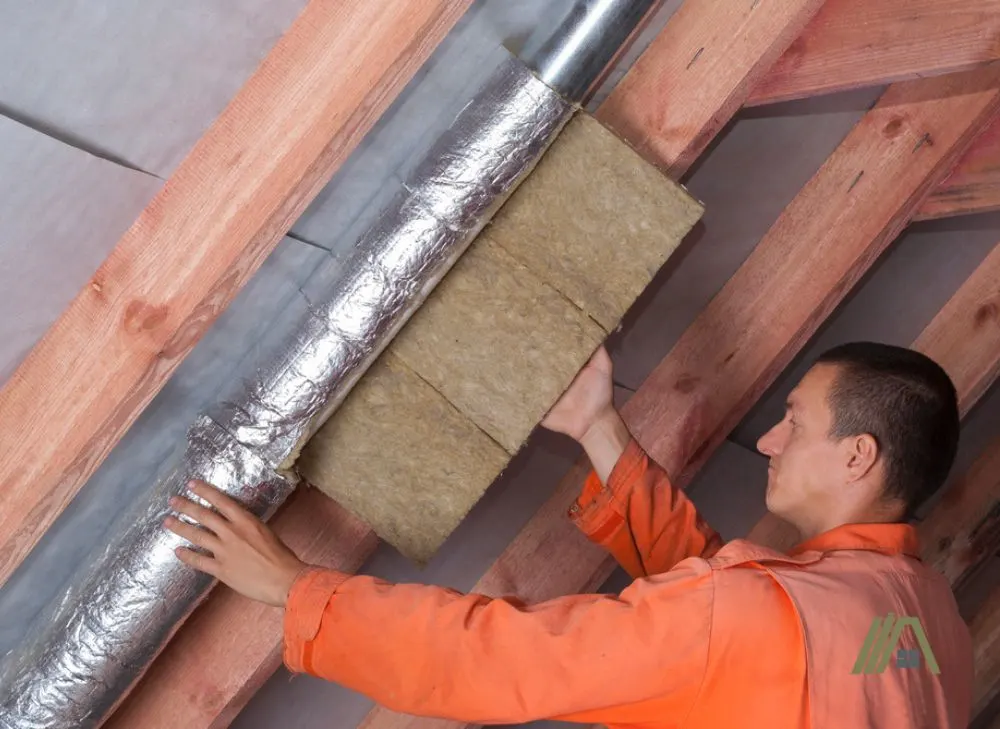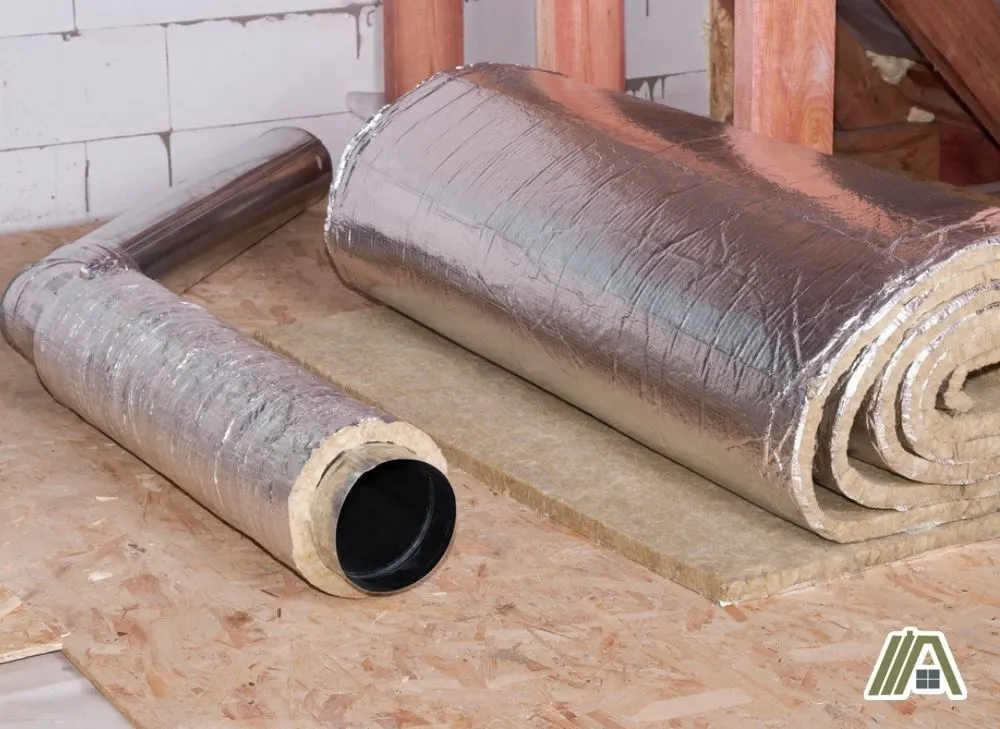Insulation is one of the hidden heroes in many homes. It does wonders for preventing problems and lowering your utility bills. So, since it is an integral part of homeowning, it’s also essential to know how much to use where.
The amount of insulation you need for a duct depends on what type you use. There are characteristics of insulators that make them more or less efficient or suitable for ducting. So, let’s look at what R-values you get for different materials and how much you will need.

Different insulators need to be installed in different thicknesses depending on the inherent R-value of the type and variation of material being used. The location of the insulation will also affect what R-value needs to be achieved.
Thickness to R-Value Depends on Insulation Type
R-value represents effectiveness in preventing conductive heat transfer. In order to achieve a certain R-value for the duct, you will need a specific thickness of material.
The thickness will depend on what material you are using since different materials have different inherent thermal resistance. Certain materials have higher inherent thermal resistance, meaning you will need less for insulating.

However, some insulators are better for different areas, which can impact what you choose to use, which in turn influences how much you will need. For example, foam boards cannot be bent, making them impractical for insulating ducts.
Inherent R-Values of Different Insulation Types
There is a typical inherent R-value per inch of an insulation material, which impacts how much you will need.
For the most part, you have an expected range for the R-value of different insulating materials, as listed in the following table:
| Cellulose (loose-fill) | R3.2-R3.8 |
| Fiberglass (loose-fill) | R2.2-R2.7 |
| Fiberglass (batt) | R3.1-R3.4 |
| Foam boards | R3.6-R8.0 (depending on the type) |
| Mineral wool | R2.8-R4.3 |
| Natural fiber | R2.0-R3.8 (value differs according to which version you are using) |
| Plastic fiber | R4.0-R7.2 |
| Polyurethane spray foam (open-cell) | R3.5 |
| Polyurethane spray foam (closed-cell) | R6.0 |
How Thick the Insulation Must Be
As I said earlier, you will need different amounts of insulators in order to achieve certain R-values to provide the correct protection.
There are various factors determining what your duct insulation R-value needs to be, but it typically ranges from R1.9-R10. As such, the table below will provide the thicknesses required to achieve several key R-values in this range.
Just note that a range of R-values can be associated with some insulating materials. Because of this, I will be providing an upper and lower estimate of the inches you will need for the range indicated in the above section.
| R1.9 | R2.5 | R3 | R3.5 | R4 | R5 | R6 | R8 | R10 | |
| Cellulose (loose-fill) | 0.5-0.59” | 0.65-0.8” | 0.79-0.94″ | 0.92-1.09″ | 1.05-1.25″ | 1.32-1.56″ | 1.58-1.88″ | 2.1-2.5″ | 2.6-3.13″ |
| Fiberglass (loose-fill) | 0.7-0.86″ | 0.93-1.14″ | 1.11-1.36″ | 1.3-1.59″ | 1.48-1.82″ | 1.85-2.27″ | 2.22-2.72″ | 5.3-3.64″ | 3.7-4.55″ |
| Fiberglass (batt) | 0.56-0.61″ | 0.74-0.81″ | 0.88-0.97″ | 1.03-1.13″ | 1.18-1.29″ | 1.47-1.61″ | 1.76-1.94″ | 2.35-2.58″ | 2.94-3.22” |
| Foam boards | 0.24-0.53″ | 0.31-0.69″ | 0.38-0.83″ | 0.44-1.17″ | 0.5-1.11″ | 0.63-1.39” | 0.75-1.67″ | 1-2.67″ | 1.25-2.78” |
| Mineral wool | 0.44-0.68″ | 0.58-0.89″ | 0.7-1.07″ | 0.81-1.25″ | 0.93-1.43″ | 1.16-1.79” | 1.4-2.14″ | 1.86-2.86″ | 2.33-3.57” |
| Natural fiber | 0.5-0.95″ | 0.66-1.25″ | 0.79-1.5″ | 0.92-1.75″ | 1.05-2″ | 1.36-2.5” | 1.58-3″ | 2.11-4″ | 2.63-5” |
| Plastic fiber | 0.26-0.48″ | 0.35-0.63″ | 0.38-0.75″ | 0.45-0.88″ | 0.51-1″ | 0.64-1.25” | 0.77-1.5″ | 1.03-2″ | 1.28-2.5” |
| Polyurethane spray foam (open-cell) | 0.54″ | 0.71″ | 0.86″ | 1″ | 1.14″ | 1.43” | 1.71″ | 2.29″ | 2.86” |
| Polyurethane spray foam (closed-cell) | 0.32″ | 0.42″ | 0.5″ | 0.58″ | 0.67″ | 0.83” | 1″ | 1.33″ | 1.67” |
Choosing the Right Insulation
When it comes to choosing insulation, it is typically better to use less of a “stronger” material (with a higher inherent R-value) than more of a “weaker” material. However, the catch here is that the “stronger” insulation materials are generally more expensive, which can be impractical budget-wise.
For example, you might pay $1.20 per ft3 (as an upper limit) for cellulose batts but $1.50 per ft3 for closed-cell spray foam. While closed-cell spray foam is very durable and effective, it can get expensive.
So, you need to find a balance, which should be heavily influenced by where you put the insulation.
In this case, you are insulating a duct to avoid a variety of condensation troubles. So, you want batts that can be wrapped around the duct, or you want blown-in or a type that can fill the cavity around ducting.

Another aspect to consider is what properties you want for ducting. Ducts can have issues with leaking as they age or get damaged, which might influence which insulation you pick. Some insulations are better at resisting water and mold growth from being wet.
This is why it is important to consider the different compositions, properties, advantages, and disadvantages of the different insulation you can choose from.
